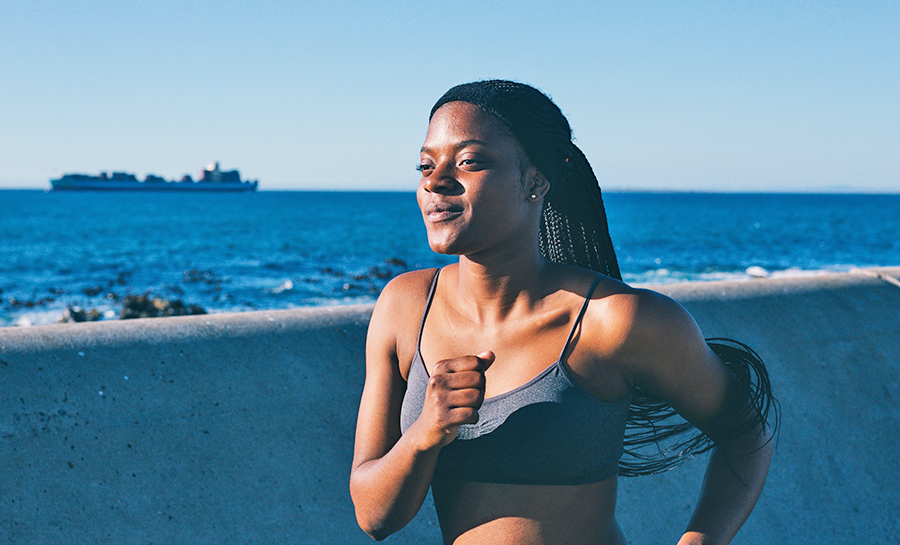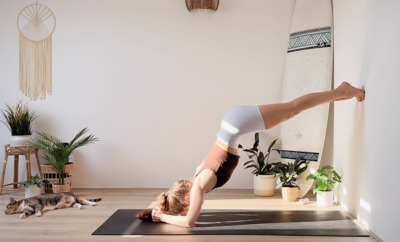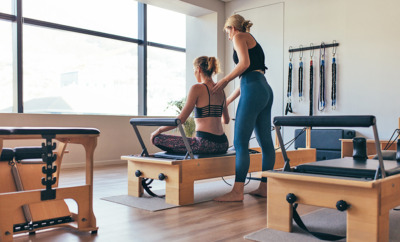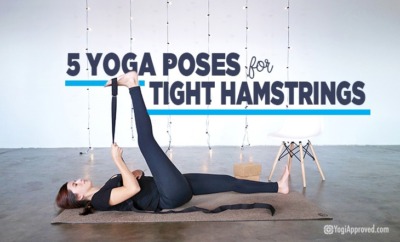5 Fitness Routine Musts for a Balanced Workout: Are You Missing Any?

Fitness seems to be everywhere these days. From wearable technology that counts your steps to gym memberships, from group training classes to social media influencers, deciding what to do to create a well-balanced fitness routine can all be a little overwhelming.
Cardio or strength training are the main focus of most workout plans. It’s no wonder, as they are great for your body and mind. But, if you’re focused on those alone, then you’re missing out on a slew of benefits for your overall well being.
There’s no universal answer for what exercises create the best workout. Much of that is individualized based on preferences and exercise history. But, there are five components that should be included in any routine to create the best workout plan.
For a well balanced fitness routine, be sure to include aerobic exercise, strength training, core exercises, balance training, and flexibility exercises.
Use these elements to create a well-rounded approach that promotes health and wellbeing.
5 Components of a Well-Rounded Fitness Routine:
Instill confidence and create a well-rounded workout routine by including the following five elements into your workout plan.
1. Aerobic Exercise
Aerobic exercise, or cardio, is all about taking care of your heart and lungs. Your heart is a muscle, and like the rest of your muscles, it needs a workout in order to stay in optimal condition.
Cardio gets your heart pumping and causes you to breathe faster and deeper. This in turn maximizes the fresh oxygen in your blood, aids your body to remove waste such as lactic acid and carbon dioxide, and works to strengthen your heart and lungs.
The US Department of Health and Human Services recommends at least 150 minutes of moderate aerobic exercise, or 75 minutes of vigorous aerobic exercise, every week. Cardio can be done at a gym on a machine, at home with limited equipment or in the community with no equipment.
Anything that gets your heart rate up and keeps it up counts as cardio, but typical examples include:
- Jumping Rope
- Jumping Jacks
- Brisk Walking
- Jogging or Running
- Group Aerobics
- Swimming
- Box jumps
- Rowing
- Dancing
- Climbing Stairs
- Hiking
- Boxing or Kick-Boxing
- Trampoline-ing
- Cycling
- Hiking
- Hula-Hooping
- Burpees
You don’t have to do all your cardio in a single 150 minute session for it to count. Try splitting it up into smaller bites, such as 30 minutes 5 times a week.
Add This High-Energy Cardio Class to Your Fitness Routine!
Prepare to challenge your body – and have fun doing it! – in this high-energy YA Classes class that combines yoga and HIIT for cardio with strengthening and agility for the ultimate yoga-HIIT-fusion workout.
2. Strength Training
Strength training focuses on your ability to pick up and move heavy things. It builds and tones muscles, helps to strengthen bones and can even increase your metabolism and manage your weight.
Strength training can be done with machines, free weights, resistance bands, kettlebells, barbells or even using your own body weight. You don’t have to join an expensive gym or use machines to get your strength training in. You can use everyday household items like gallons of water, soup cans, or backpacks filled with books.
Strength training builds and tones muscles, strengthens bones and can increase your metabolism and manage your weight.
When strength training, you want to work all your major muscle groups: legs, arms, shoulders, chest, back, hips and glutes.
You can do a full-body strength training workout each time, or switch every session between upper and lower body. There are merits to both, so stick to whichever feels better for your body. Aim to work each muscle group at least twice a week.
A general rule of thumb for beginners is to use enough weight that your muscles get tired after 10-12 repetitions. You’ll find your ability to lift weights improves over time. Increase the load by either adding more repetitions or increasing the weight you are lifting.
Common strength training exercises include:
- Squats
- Lunges
- Pullups
- Pushups
- Farmers Walks
- Deadlifts
- Overhead Press
- Bench Press
- Tricep Extension
- Bend Over Rows
Afraid of “bulking up” from strength training? Stop Believing These 5 Outdated Myths About Women’s Fitness
3. Core Exercises
There’s so much more to core work than having six-pack abs. Our core includes the muscles of our trunk including the abdominals, obliques, pelvic floor, hip flexors, glutes and lower back. These muscles work both to stabilize the spine and pelvis as well as produce movement.
Having a strong core is a vital component of a well-balanced fitness routine.
A strong core is important for balance and stability, good posture, a healthy spine and injury prevention. Additionally, it makes daily activities like housework, gardening, child care, playing with your pets or even sitting or standing for long periods easier.
Work your core through either compound or targeted exercises. Compound exercises work multiple muscle groups at once, such as a plank. Targeted exercises isolate the work in the core, such as crunches. Incorporate core work into your fitness routine at least twice a week and you’ll notice an improvement in your overall body functioning.
Common core exercises include:
- Glute Bridges
- Bird Dog or Bird Dog Crunches
- Plank, Side Plank and Roll-Out Plank
- Kettlebell Swings
- Mountain Climbers
- Medicine Ball Twists
- Turkish Get-Up
Fitness Routine Must: Hard Core Class on YA Classes
A powerful core helps prevent injury and take your workouts to the next level. Hard Core is a YA Classes designed to strengthen and tone your core. Set to a killer playlist with a motivating instructor, this class guides you through a sweaty, hardcore abs workout – perfect to add to your fitness routine.
4. Balance Training
Balance training is an often overlooked component of a well-rounded fitness routine. Training your balance helps to improve agility, increases your technique when completing exercises, improves coordination and helps to prevent falls and injury in everyday life.
Balance training is particularly helpful for older adults, but should be incorporated into your workout routine at any age. Young adults should practice balancing exercises twice a week. As you age, increase the frequency to include balance training every day.
Balance training doesn’t have to be tricky to be effective. Things like standing on one leg, walking on your tip-toes, or practicing getting up and down off the floor are all effective ways to work on your balance.
Improve your balance with any of these exercises:
- Tai Chi
- Yoga
- Balance Board Exercises
- Stability Ball Exercises
- Single Leg Deadlifts
- Heel-Toe Walking
- Tip-Toe Walking
- Reverse Lunges
- Dead Bug
Did you know that exercising in the morning helps to improve decision making? Well, It’s Confirmed: Morning Exercise Will Significantly Improve Your Decision Making (Here’s Why)
5. Flexibility & Stretching
Flexibility and stretching keep our muscles and joints supple so they can move through their full range of motion. They also inspire improved posture, increase circulation, improve physical performance and help to relieve stress. Beyond that, it just feels good.
Stretching comes in two forms, active and passive. You’ll want to include both in your workout plan.
Passive stretching, or static stretching, relies on time held in a position to stretch your muscles. An example is a reclined hamstring stretch. Passive stretches are generally held for 10-30 seconds.
Active stretching, sometimes called dynamic stretching, is where you actively use your muscles to move your joints through their full range of motion. An example of this is a reclined hamstring stretch where you bend and straighten your leg 10 times.
Stretching should always be gentle.
You want to feel slight resistance or tension in your muscles, but nothing should hurt, throb, or feel like it’s about to snap. Spend 5-10 minutes doing dynamic stretches before your workout to ensure your muscles are warm and to help prevent injury.
Do 5-10 minutes of passive stretches after your workout to help cool down and reduce the accumulation of lactic acid in the muscles.
Examples of Dynamic Stretches:
- Hip Circles
- Walking lunges
- Arm Circles
- Leg Swings/Toe Touches
- Butt Kicks
- Plank Walk Outs
Examples of Passive Stretches:
- Seated Forward Fold
- Butterfly
- Supine Twist
- Knee to Chest
- Cross Body Arm Stretch
- Quad Stretch
- Bent Arm Wall Stretch
Get Flexible With Us! Take This Full Body Flexibility Program on YA Classes
Join Jess Rose as she guides you through an intelligent and intentional 5-class series to help you gain full-body flexibility. These classes are broken into lower body focus, upper body focus, and a full-body flow that ties it all together.
Bonus Component: Add Fun to Your Fitness Routine
Just as important as these five fitness factors for a well-rounded and balanced fitness routine, your workout should be fun! Working out should never feel like a chore. In order to stick with your plan, it has to be something you look forward to and prioritize.
Bring joy back to your plan by working out with a friend or trying something new.
Channel Your Inner Child With These 6 Childhood Activities Disguised as Workouts
Final Tips For A Balanced Fitness Routine
Safety is key to any fitness routine. If you’re new to working out, it’s always best to consult with a doctor or healthcare provider first. Start small and work on your technique. Build up from there until you have a robust routine.
The gym can be an intimidating place for anyone new to fitness. But don’t let the muscle heads scare you.
Use these five elements of fitness to instill confidence and create a well-rounded workout routine that will serve you now and for years to come. Incorporating all of these elements may seem like a lot, but it will help you reach your fitness goals and boost your overall well being.
All included information is not intended to treat or diagnose. The views expressed are those of the author and should be attributed solely to the author. For medical questions, please consult your healthcare provider.


This Month's Letter
From the Editor
Monthly motivation and food for
thought from our founder.





























